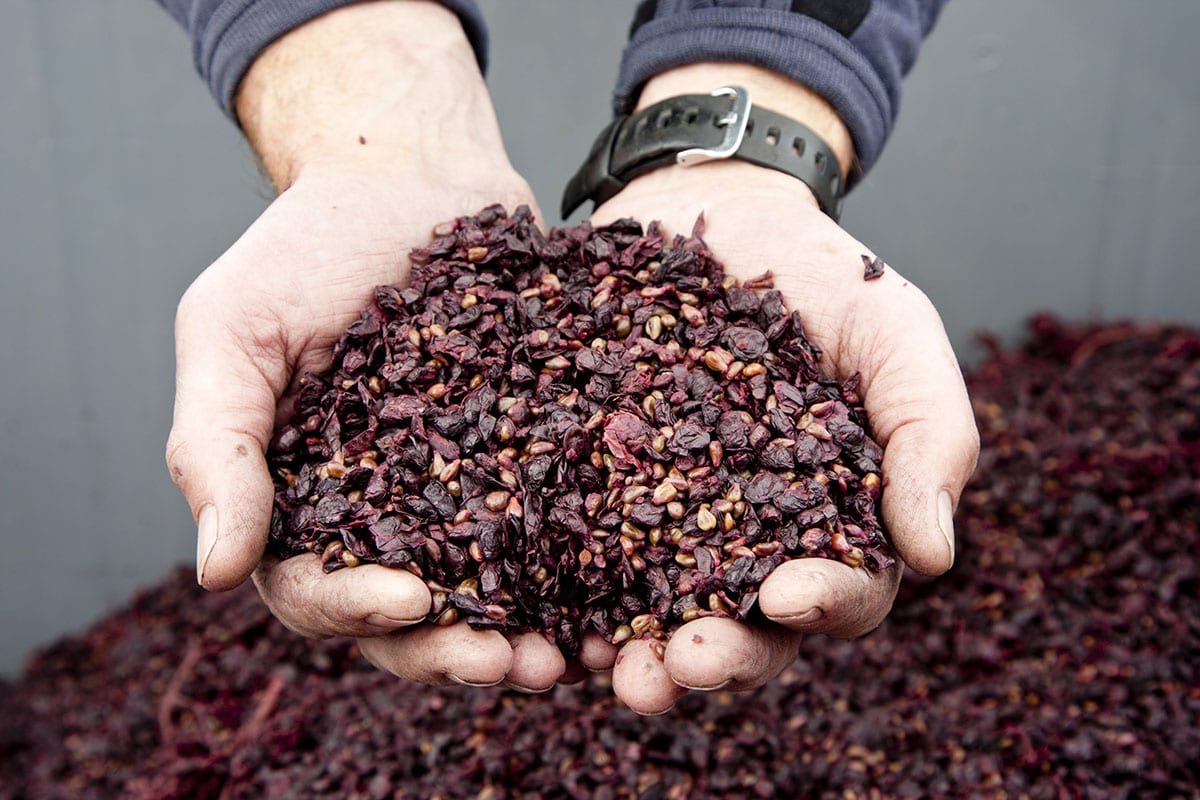A research project to turn winery waste into hand sanitiser helped Marlborough health care workers in their fight against the pandemic while adding value to the wine industry’s largest waste stream.
This short-term pilot study carried out by the BRI with $84,700 funding from the Ministry of Business, Innovation and Employment’s Covid-19 Innovation Acceleration Fund, explored transforming grape marc – the skins and seeds remaining after pressing – into ethanol for hand sanitiser, which was in short supply in the early days of the pandemic.
Grape marc is the largest waste problem in the wine industry, and it is growing as more grapes are planted and the industry grows. The motivation to treat marc differently is driven by environmental and regulatory pressures, with convictions already entered for illegal disposal methods, and by economic pressures as the industry seeks a cost-effective way to use or dispose of marc. There is no one silver bullet for grape marc repurposing, and the industry will need to rely on a variety of ways to repurpose this waste stream.
Other countries use marc for ethanol production, but prior to this pilot, the process was untested in the New Zealand context with our varietals. Prior to the opening of the Research Winery in February 2020, the industry would not have had the capability to conduct a study such as this in New Zealand.
The study was a collaboration between BRI and the Rai Valley Bottling Co, with grape marc supplied by wineries in Marlborough, including Indevin and Framingham.
For the study, grape marc was collected and promptly frozen until fermentation trials could be conducted. Triplicated fermentations of each treatment were carried out in 17L tanks under identical conditions.
Other methods included pulverising, enzymes, acid hydrolysis and ‘heap fermentation’, under various conditions.
Once ferments were completed, the tanks were drained, and the grape marc was pressed for full extraction. The subsequent liquid was distilled at a local distillery.
Other waste streams investigated included lees (sediment of dead yeast and grape remnants) from Sauvignon Blanc fermentations and red grape marc post fermentations, which were collected, and steam distilled at the local distillery.
The trials produced more than 100 bottles of hand sanitiser from marc-derived alcohol, which was bottled and donated to local health care workers in the Marlborough region including St. Johns, Red Cross, and local medical centres. In addition, the wineries that donated grape marc were given bottles of the hand sanitiser for their staff to use.
This consolidated BRI’s position in the community, helping to build a sense of regional solidarity and a connection between the people of the Marlborough region and its most important economic sector. This was significant because, at the time, the research winery had been open for only a year, and also served as publicity for the winery’s fermentation trial capability.
Research showed a positive finding of a reduction in the weight of grape marc post fermentation by up to 36 per cent, when used to produce ethanol. While there is still a significant amount of remaining marc to be disposed of, this finding could benefit wineries that are paying for disposal based on weight.
A comprehensive business model to produce ethanol from winery grape waste was developed. And while production cost may outweigh the benefit, if the production of hand sanitiser is the only objective, this is offset by other economic, social, and environmental benefits. In addition, the process’s economics may become more attractive if incorporated into an integrated system of multiple processes for treating the same waste.
Research findings were distributed via the NZ Winegrowers and BRI websites, internal newsletters, plus press releases and subsequent media articles.
The impact (in the short term) was the pilot scale production of hand sanitiser from marc-derived alcohol, as well as the development of a connection between the winegrowing industry and the programme to manage COVID-19 and other diseases, and technical data to support a scaled development. These will benefit the wine industry, and the Marlborough region, economically and environmentally.
The information dossier delivered by this project contributes to industry discussions about the management of marc and will be used by BRI as it creates options for the industry through research and technical development. This is a complex mix of considerations and the information from this project is a valuable part of the process of finding a solution.
The full value proposition of this project goes beyond waste management and producing a low-cost ethanol source. For Marlborough, the New Zealand winegrowing industry and New Zealand, the benefits include adding value to large and problematic industry waste streams, creating a product known to be effective in disease control, demonstrating diversification options for the New Zealand winegrowing industry, and presenting an opportunity for the Marlborough winegrowing industry to connect with pandemic responses and community healthcare in a tangible way.
This project trialled technology that could be adapted to facilitate ethanol-based sanitiser production from other horticultural waste streams, such as those from the apple and pip fruit industries.
This project also enabled BRI to trial frozen grape marc to utilise the winery capability during off-peak times, after industry harvest. Most commercial wineries sit idle for several months of the year, which is different to other food manufacturing businesses, and the BRI research winery is continuing to seek projects to continue research during off-peak months.

















